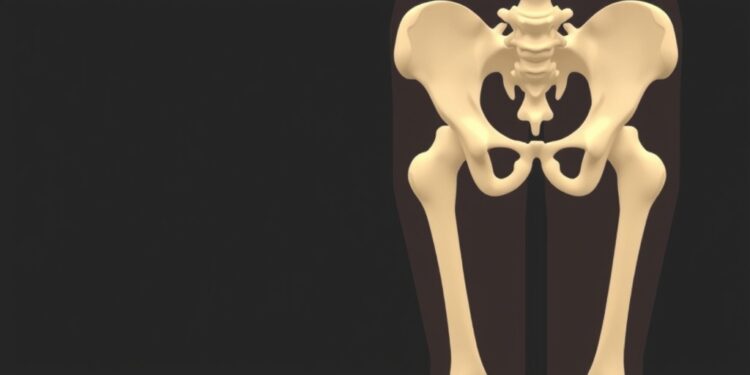A groundbreaking study exploring the morphology of the human pelvis has recently emerged, employing a sophisticated blend of genetics and advanced deep learning techniques to analyze data from over 31,000 individuals. Researchers have reported that this comprehensive investigation reveals essential genetic correlations between the anatomical structure of the pelvis and its implications for biomechanical functions such as locomotion and childbirth. The findings provide significant insights into how human evolution has navigated the complex balance between the demands of bipedal movement and the intricacies of giving birth.
The evolutionary journey toward bipedalism distinctly influenced the morphology of the pelvis in hominins. This adaptation catalyzed notable transformations, leading to a pelvis that is characteristically shorter and broader. Such changes were pivotal in promoting an upright posture and enhancing efficiency in locomotion. However, these morphological advantages came with a considerable trade-off. The pelvic adjustments that facilitate bipedal locomotion concurrently posed challenges for childbirth. Specifically, the constriction of the birth canal rendered the passage of larger-brained infants increasingly problematic, illustrating the longstanding conflict encapsulated in the term "obstetrical dilemma." This term has fueled ongoing debates in evolutionary biology and anthropology for decades.
One proposed resolution to this obstetrical dilemma suggests that evolutionary pressures may have driven humans to bear less developed infants, easing their traverse through the birth canal. Nonetheless, recent investigations have presented conflicting evidence, revealing that human gestational periods and newborn sizes are analogous to those observed in other primates of comparable sizes. Such findings complicate the understanding of human childbirth in the context of evolutionary adaptation and challenge prevailing narratives about our developmental processes.
Despite advances in functional genomic studies focusing on gene expression and comparative analyses between humans and great apes, a substantial gap has persisted regarding the genetic underpinnings of human pelvic morphology. To fill this void, the research team led by Liaoyi Xu utilized state-of-the-art full-body dual-energy x-ray absorptiometry (DXA) imaging methodologies and extensive genetic data drawn from the UK Biobank, which comprises 42,284 individuals. By deploying a comprehensive deep-learning framework on 39,469 high-quality DXA images, the team successfully derived an extensive assortment of 7 skeletal measurements of the human pelvis.
Further, the team conducted genome-wide scans aimed at identifying genetic loci associated with the variability in pelvic proportions. This meticulous process yielded an impressive discovery of 180 distinct genetic loci linked to variations in pelvic shape. Notably, the researchers uncovered substantial sex-specific differences within the genetic architecture governing pelvic morphology. Additionally, they identified asymmetries in pelvic structure corresponding to handedness, indicating that genetic predispositions may also influence skeletal development beyond mere morphology.
In a fascinating twist, the study revealed that wider birth canals are not merely a passive byproduct of pelvic evolution; rather, they are genetically linked to slower walking speeds and an increased risk of pelvic floor disorders. However, intriguingly, wider birth canals were also associated with a reduced risk of obstructed labor during childbirth. This multifaceted relationship underscores the complexity of evolutionary adaptations and their implications for health outcomes in modern humans.
Perhaps one of the most significant findings of this study challenges previously held assumptions regarding gestational duration. Contrary to the supposition that shorter gestation periods evolved as a mechanism to facilitate childbirth, the research team found no evidence supporting this hypothesis. However, they did identify notable genetic correlations between pelvic morphology and head size, implying potential evolutionary adjustments in response to the challenges posed by birthing larger craniums.
The implications of these findings extend far beyond academic interest; they may profoundly impact clinical practices in obstetrics and gynecology. Understanding the genetic factors influencing pelvic morphology could pave the way for novel approaches in managing childbirth, particularly for women at risk of complications related to pelvic dimensions. Additionally, these insights may inform personalized healthcare strategies, allowing for tailored interventions that align with individual genetic profiles and anatomical considerations.
As our understanding of the human pelvis evolves, so too does our perspective on the intricate relationship between anatomy, genetics, and evolutionary biology. This comprehensive study not only sheds light on the specifics of pelvic morphology but also invites further research into the broader implications of these findings on human evolution. It emphasizes the interconnectedness of form and function, ultimately enhancing our grasp of what it means to be human.
This significant research not only provides clarity to historical debates in the field but also serves as a catalyst for future inquiries into the genetic and environmental factors that shape human anatomy. As scientists continue to unravel the complexities of our biological heritage, studies like this will play a crucial role in advancing our understanding of human evolution in the context of modern health.
In conclusion, the research conducted by Liaoyi Xu and their colleagues represents a pivotal step forward in articulating the intricate genetic and evolutionary dynamics at play in the human pelvis. Through a meticulous examination of genetic data and innovative imaging techniques, this study unlocks new possibilities for understanding our species’ evolutionary past and could very well influence the trajectory of future obstetric care, reaffirming the relevance of evolutionary biology in contemporary health contexts.
Subject of Research: Human Pelvic Morphology
Article Title: The genetic architecture and evolutionary consequences of the human pelvic form
News Publication Date: 11-Apr-2025
Web References: DOI
References:
Image Credits:
Keywords: human pelvis, bipedalism, childbirth, genetics, evolutionary biology, pelvic morphology, deep learning, genome-wide analysis, obstetrical dilemma, pelvic floor disorders, gestation, cranial size.




